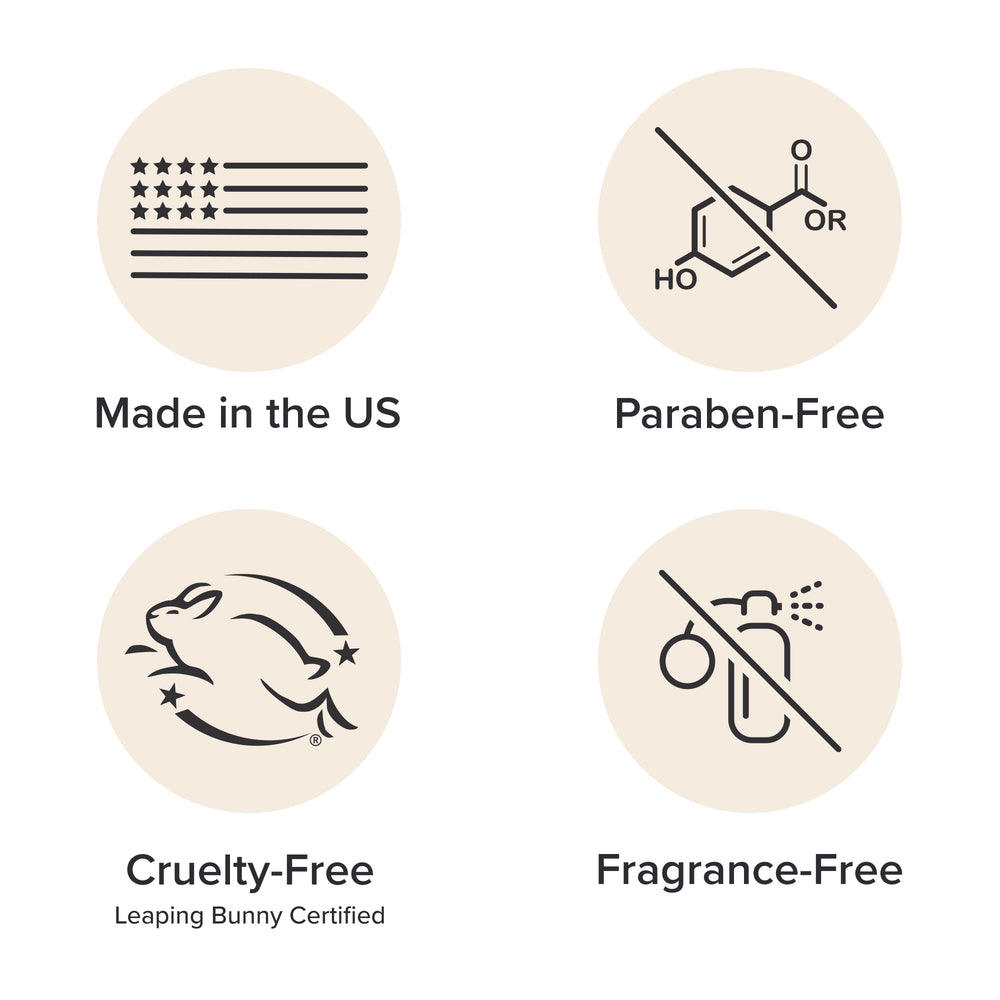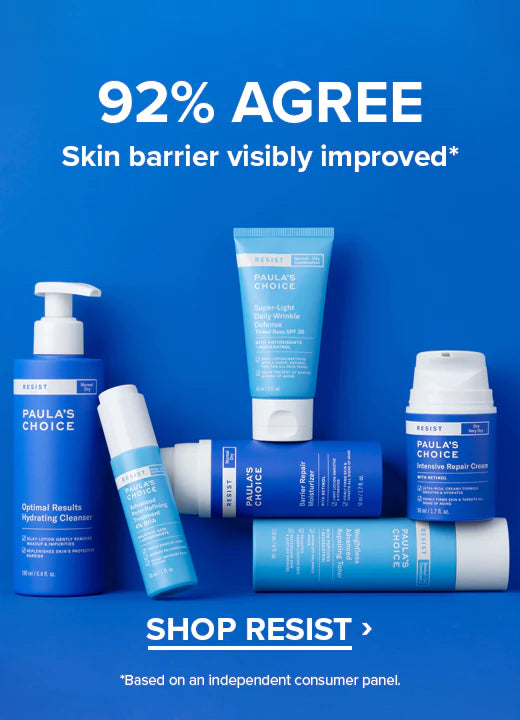Written by: Bryan Barron
Medically Reviewed by: Corey Hartman MD Board-Certified Dermatologist
Few skin care topics have become as mired in confusion and worry as pH. How can two little letters have such an impact on our skin? As it turns out, how pH relates to our skin and the products we use is fascinating. And despite the worry, finding pH-balanced skin care is easier than you might think. We’ll put your mind at ease about using skin care products with different pH levels so you can get through your routine faster.
What is pH?
The term “pH” refers to “potential of hydrogen”. It concerns the activity of hydrogen ions (ions are molecules that carry a positive or negative charge) in a water-based solution. Hydrogen makes up two thirds of water, water being two hydrogen molecules plus an oxygen molecule, H²o.
The pH of a solution is indicated by a numeric scale that runs from 0-14. Anything below 7 (which is pH neutral) is considered acidic, while anything with a pH greater than 7 is considered alkaline. Lemon juice has a pH of 2—very acidic, while ammonia has a pH of 12, which is highly alkaline, also referred to as basic, as in acids and bases.
It’s important to know that while the differences between pH numbers might seem small by normal math, the pH scale is logarithmic, not linear. That means a tenfold increase multiplied by 10 separates each pH number. It’s why a pH of 3 is 100 times more powerful than a pH of 5.
You can also think of the difference between each pH number like the Richter scale used to measure the strength of earthquakes. A quake with magnitude 6 is capable of significantly greater damage than one whose magnitude is measured at 4 or 5.
What is the pH of skin?
It might surprise you to find out that skin’s surface and uppermost layers are naturally acidic, making it compatible with acidic skin care products. Although research on skin’s pH range cites various numbers, the collected research shows skin’s average pH is 4.7.
Men’s skin tends to be more acidic than women’s skin, and although the pH of our skin increases with age, it remains acidic. When we’re born our skin has a neutral pH that becomes acidic within a couple weeks of birth.
What is skin’s acid mantle?
Skin has a protective film on its surface that’s known as its acid mantle. The acid mantle plays a vital role by working with skin-natural ingredients like ceramides, cholesterol, enzymes, sweat, and even our skin’s own oil to protect skin’s surface and lower layers from external threats.
Skin’s acidic pH also plays a role in keeping its delicate microbiome balanced. An acidic microbiome makes it more difficult for harmful pathogens to multiply but lets the good stuff flourish.
How pH affects skin
Repeatedly disturbing skin’s pH to a strong degree can lead to or worsen many problems, including common skin disorders and that dry, tight feeling from washing with bar or liquid soaps (most soaps are alkaline).
In order to avoid problems, many people look for pH-balanced skin care products, but not all products are labeled with their pH levels. What to do? We have encouraging news: The vast majority of rinse-off and leave-on skin care products are already pH-balanced. Cosmetic chemists are aware of how the pH of skin care products impacts our skin, so they usually take formulary steps to ensure a balance.
If you’re wondering what’s meant by “pH-balanced”, it refers to products formulated with a pH that falls in the range of normal, healthy skin. That range is most often cited as being between pH 4 and pH 7. Although it’s true that some skin care products have pH numbers outside this range, in most cases this isn’t cause for concern.
Research has shown that mild disruptions in skin’s pH (such as from using a leave-on AHA or BHA exfoliant whose pH is 3.6 or a mineral sunscreen with a pH of 7.5) are temporary. The skin naturally equalizes to its normal pH, typically within an hour. And there’s actually a benefit: Research has shown that acidic products stimulate skin to produce key substances it needs to look smooth, supple, and hydrated.
On the other hand, using highly acidic (pH 2.5 or lower) or alkaline (pH 8 or greater) products causes a more significant disruption in skin’s pH, so it takes skin longer to get back to normal.
During this extra time, skin is vulnerable to factors that can trigger breakouts, signs of eczema, redness and sensitivity. That’s why daily use of products whose pH is too high or too low visibly and progressively damages skin.
The pH of skin care products
We mentioned above that most skin care products are pH balanced, and this applies to products from Paula’s Choice, too. Here are common pH ranges for the major categories of our skin care products:
- Cleansers: pH 4.5–7
- Toners: pH 5–7
- Sunscreens: pH 5–7.5
- AHA and BHA Exfoliants: pH 3.2–3.9, with any reading between 3 and 4 considered most effective
- Moisturizers: pH 5–7
- Serums: pH 4–6
- Vitamin C (ascorbic acid) products: pH 2.6–3.2
- Retinol products: pH 4–6.6

Can you layer skin care products with different pH levels?
We’re often asked if it’s OK to immediately layer products with differing pH levels, such as applying a moisturizer over an AHA exfoliant. People worry that doing so causes one or both products not to work because the different pH levels conflict with each other. Concern about this interaction means many people wait 20 minutes or more before applying another skin care product. Surprise: You don't have to wait!
The reason you don’t have to wait is because once the pH range of a water-based product is established, it will hold within that range even when applied at the same time as products outside that pH range. That’s because the ingredients chemists use to establish a product’s pH range are strong enough to keep it within the desired range no matter what you apply at the same time.
It’s far easier to disrupt the pH of your skin than it is to do so to skin care products. In order to move the product’s pH out of its range or have it significantly alter the pH of other products, you’d need to add a lot of water (which means more hydrogen ions), heat, and time (we’re talking several days).
What does heat have to do with pH? A product’s pH can shift as the temperature changes. As the temperature rises, the water in a solution makes more hydrogen molecules. Surprisingly, a big increase in temperature does not move the pH that much. For example, the pH of water at 77 degrees is 7 (neutral) and when the temp rises to 122 degrees (rare in many parts of the world) the pH drops to 6.6, not a big drop—and this is an extreme heat example.
During conditions of normal use, it’s chemically impossible for a higher-pH product to make a lower-pH product ineffective, and the reverse is also true. You can gain the visible benefits all of these ingredients provide, no need to adjust your routine!
Is sparkling water compatible with skin's pH?
Recently there have been concerns that washing with regular tap water can disrupt skin's pH, and that you should wash with sparkling water instead. The issue is based on tap water having a pH of 7 and being perceived as too high for skin’s pH of 5.5 to 4.5. The claim is that because carbonated or sparking water has a pH of 5.5, it’s more compatible with skin.
Though this sounds reasonable, it's not an issue for a couple of reasons. First, most sparkling water doesn't have a pH of 5.5, and instead has a pH between 3 and 4, but even if sparkling water had a pH of 5.5, that's still higher than most people’s natural pH. Second, a neutral pH of 7 (which is what tap water has) is less disruptive of skin’s natural pH than any other pH number. Long story short, it's just fine to wash your skin with plain old tap water!
Learn more about skin care myths.
References for this information:
- Current Problems in Dermatology, August 2018, pages 1-10
- The Journal of Clinical and Aesthetic Dermatology, July 2017, pages 33-39
- Acta Dermato-Venereologica, March 2013, pages 261-269
- Photochemistry and Photobiological Sciences, April 2010, pages 578-585
- International Journal of Cosmetic Science, October 2006, pages 359-370
- Skin Pharmacology and Physiology, July 2006, pages 296-301
- Folding and Design, August 1998, pages 285-291







